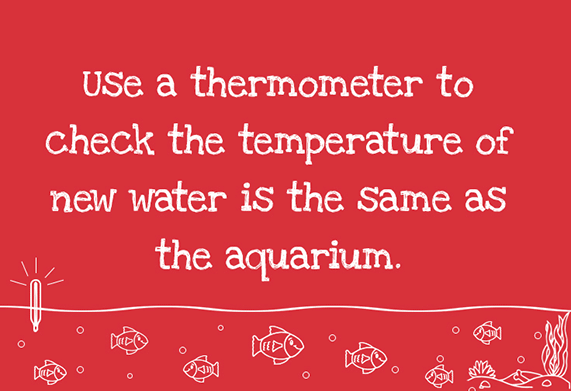Understanding water pH in your aquarium
In this guide we’ll explain how the pH levels in your water can impact your aquarium and what you can do to lower high levels.
Maintaining ideal water conditions in an aquarium can be a challenging task. One of the common issues that can arise is high water pH levels. This can negatively affect the health and well-being of your aquatic inhabitants.
In its most basic terms, pH is the way of indicating whether an area of water is acid, alkaline or neutral.

pH is measured on a scale of 1 to 14: 1 is pure acid, 14 is pure alkaline and 7 is neutral.
Managing pH levels is vitally important to success in fishkeeping as fish must have a healthy and balanced environment to survive. A safe aquarium pH varies from fish to fish, but is typically between 6.5 to 8.5.
How does pH affect water?
To better understand pH, we need to delve further into the chemistry of water. We all know that water’s chemical description is H2O. This is a mix of free positively charged hydrogen ions (H+) and negatively charged hydroxyl ions (OH-).
It is the varying proportions of these ions that causes the differences in the water pH. If there are more OH- ions then water will be more alkaline. But if there are more H+ ions then the water will be more acidic.
pH can be affected without you realising. All it takes is for new minerals to be added to the water. They will release ions which will contribute to the dominance of either the OH- or H+ ions in the water. These new minerals may be added to the water through rocks or wood used as décor, carbon dioxide from respiration or from decaying food or plants.
Is high pH water bad for fish?
High or low pH can cause unexplained fish death, irritability in your fish, gasping at the surface and changes in colouration amongst other issues.
Like many other water quality issues, changes in pH in your aquarium are invisible and unless you test your water regularly you will only notice the issue when things start to go wrong.
Did you know that for every increase of one pH, there is a 10-fold change in the concentration of hydrogen ions?
For instance, a pH of 6 is 10x more acidic than a pH of 7, and a pH of 5 is 100x more acidic than a pH of 7! As you’ll see, even a ‘small’ change in pH has a big impact on the water in which your fish live, so regular pH testing is crucial to happy and healthy fish.
pH lowering products often claim to contain a “buffer”. Simply put, a buffer is a way of using chemicals to prevent pH falling to a dangerous level.
The chemicals will prevent the dominance of H+ ions and help a stable pH.
Buffers can be added by the use of certain products, but they may be naturally present in tap water. Hard water contains minerals, and these minerals are the natural buffers that help stabilise the pH in your water.
Soft water does not contain these mineral buffers, so if you live in a soft water area you may experience more issues with a fluctuating pH.
To better understand pH, we need to delve further into the chemistry of water. We all know that water’s chemical description is H2O. This is a mix of free positively charged hydrogen ions (H+) and negatively charged hydroxyl ions (OH-). It is the varying proportions of these ions that causes the differences in water pH. If there are more OH- ions then water will be more alkaline. But if there are more H+ ions then the water will be more acidic.
pH can be affected without you realising. All it takes is for new minerals to be added to the water. They will release ions which will contribute to the dominance of either the OH- or H+ ions in the water. These new minerals may be added to the water through rocks or wood used as décor, carbon dioxide from respiration or from decaying food or plants.
Did you know that for every increase of one pH, there is a 10-fold change in the concentration of hydrogen ions?
For instance, a pH of 6 is 10x more acidic than a pH of 7, and a pH of 5 is 100x more acidic than a pH of 7! As you’ll see, even a ‘small’ change in pH has a big impact on the water in which your fish live, so regular pH testing is crucial to happy and healthy fish.
pH lowering products often claim to contain a “buffer”. Simply put, a buffer is a way of using chemicals to prevent pH falling to a dangerous level. The chemicals will prevent the dominance of H+ ions and help a stable pH. Buffers can be added by the use of certain products, but they may be naturally present in tap water. Hard water contains minerals, and these minerals are the natural buffers that help stabilise the pH in your water. Soft water does not contain these mineral buffers, so if you live in a soft water area you may experience more issues with a fluctuating pH.
How does pH affect aquarium fish?
Fish have also learnt to adapt to changes in pH. Before you decide what fish you want in your aquarium it is worth considering the type of water you have and the natural pH.
Depending on their origins fish have become used to certain surroundings which generally include varying combinations of temperature, water hardness and pH.
If you have naturally acidic, soft water you are going to have to work more to keep fish that prefer harder, more alkaline water so it is important to speak to your aquatic retailer before taking certain fish on.
High pH levels in your aquarium can potentially harm your fish in several ways, including:
- Increase in ammonia and nitrite levels, which can be toxic to fish
- Stress on fish, making them more susceptible to disease
- Imbalance of minerals, leading to health issues
- Decrease in oxygen levels as some fish may have difficulty breathing
What is a good pH for my fish tank?
The ideal pH for your fish tank depends on the type of fish you are keeping. Generally speaking, most fish thrive in water with a pH between 6.5 and 8.5, although some species have specific requirements outside of this range.
Fish that require acidic conditions such as discus and tetras, do best in slightly lower pH levels between 6.0 and 7.5. While salt water fish and livebearers are more comfortable in slightly higher pH levels around 8.0.
What causes high pH in fish tanks?
High pH levels in an aquarium can be caused by a number of different factors. The most common causes are overfeeding, decaying organic matter, high levels of calcium carbonate (CaCO3), and high levels of alkaline salts such as sodium bicarbonate.
Other causes can include:
- Adding too much alkaline substances such as baking soda, limestone, coral sand or shells to the tank.
- Using tap water that is high in pH.
- Using products that contain phosphates, nitrates and other chemicals which can increase water alkalinity.
How do I know if my pH is too high?
The best way to determine the pH level of your aquarium water is with a test kit. This will give you an accurate measurement. Most test kits measure from 0-14, with 7 being neutral and anything below that being acidic and above alkaline. Anything above 8 is considered too high for most fish.
Symptoms of low pH in fish tank
When the pH in a fish tank is low (acidic), it can have negative impacts on the health and well-being of the fish.
- Fish Stress
- Sluggishness or Lethargy
- Low appetite
- Damaged Fins and Tissue
- Abnormal Behavior
- Poor Growth and Development
- Reproductive Issues
Symptoms of high pH in fish tank
When the pH in a fish tank becomes too high (alkaline), it can have adverse effects on the health and well-being of the fish.
- Fish Stress
- Reduced Oxygen Levels
- Altered Water Chemistry
- Poor Digestion and Nutrient Absorption
- Damaged Gills and Tissue:
- Lethargy and Reduced Activity
- Abnormal Behavior
Fish have also learnt to adapt to changes in pH. Before you decide what fish you want in your aquarium it is worth considering the type of water you have and the natural pH.
Depending on their origins fish have become used to certain surroundings which generally include varying combinations of temperature, water hardness and pH. If you have naturally acidic, soft water you are going to have to work more to keep fish that prefer harder, more alkaline water so it is important to speak to your aquatic retailer before taking certain fish on.
How to conduct a pH test
Testing the pH is easy and inexpensive. There are test kits available that allow you to test your water quickly and accurately.
To perform a test, all you need to do is follow the manufacturer’s instructions. This usually involves taking a sample of aquarium water and adding a few drops of the testing liquid or powder from the kit. The resulting colour will indicate the pH and can be compared to the colour chart provided.
Once you’ve determined what the pH is, you can then decide whether it needs to be adjusted or not. If it does need to be changed, there are several products available that can help raise or lower the pH as required.
How to lower pH levels in your aquarium
If you have a high pH level in your aquarium, there are some steps you can take to safely lower pH:
- Making regular water changes. Regular water changes encourage beneficial bacteria to grow, which helps to reduce pH levels. Learn more about changing your aquarium water.
- Adding peat moss to the aquarium. Peat moss is an organic material that can slowly lower pH levels as it releases natural acids into the water. However, it can discolour your water, so be sure to use it sparingly.
- Installing a reverse osmosis filter. Reverse osmosis filters are known to be effective at lowering pH levels in aquariums. Having one installed can help to keep your water conditions stable.
- Adding driftwood and other decorations. Wood releases tannic acid into the water, which helps to lower pH levels. Not only this but it adds a nice natural look to your tank. Like peat moss, it can also affect the colour of your water.
- Using catappa leaves. Catappa leaves are known to help lower pH levels in an aquarium. They also contain natural antibacterial properties which can be beneficial to fish health. Like peat moss and driftwood, it can discolour the water in your tank.
- Using pH-lowering chemicals. Chemicals like sodium bisulfate and potassium bicarbonate can be used to lower the pH in an aquarium. Use these with caution as they can be hazardous if not handled properly.
- Make changes to the substrate. Adding certain types of gravel or sand can help to reduce alkalinity in the water. Additionally, adding rocks like limestone or clay to the tank will buffer and help maintain a lower pH level.
- Regular testing. Test the pH scale of your water ever so often to check it remains within the safe range. That way, if levels are too high you can take steps to bring them back down before any harm is done.
Do some fish prefer high pH levels?
Yes, some fish do prefer high pH levels. Certain species such as Guppies, Cichlids, and Mollies, are known to thrive in water with a higher pH level.
They tend to do better in water that is slightly basic (above 7) rather than acidic (below 7). This is because they have adapted over time to live in water with higher alkalinity levels.


